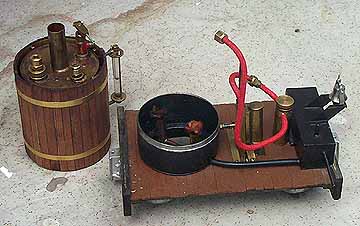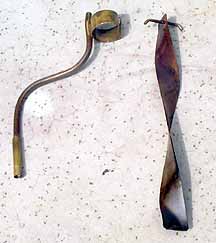
Back to Sidestreet Bannerworks
August 2002
Larry Herget's Logging Engine
by Marc Horovitz

There isn’t one. This engine is pure freelance and fantasy. It follows the “home brew” philosophy of many small logging lines, though, and has an air of plausibility about it.
The engine
This is one of a batch of six locomotives that Larry Herget built in 1993. Four were offered for sale at Diamondhead in 1994. The locomotive’s chassis is made of wood. Steel wheelsets roll in Ozark Miniatures (what else?) pedestals and multiple-pocket couplers adorn each end, even though the engine can only travel forward.
This engine is mechanically interesting, as is all Larry’s work. Perhaps its most interesting feature is the boiler, a vertical unit, approximately 3" tall by 2.5" in diameter. A 1/2" flue comes up through the middle of it. There's also a brass wrapper around the inner shell that stands off from the barrel about 1/8". This outer wrapper is lagged with wood. The boiler sits on a firebox about 1.5" high, inside of which is a two-wick alcohol burner, fed from a tank on the engine’s wooden deck. The space around the inner barrel dramatically improves the heating area (always a problem with small, vertical boilers), making this one quite efficient. It also has a flame restrictor in the flue — a twisted piece of metal that aids efficiency.
Atop the boiler are a throttle, a safety valve, and a Goodall-type filler valve. A site glass projects from the side. The boiler relies mostly on gravity to keep it in place. It can be quickly removed simply by undoing the steam line at the throttle.
The lagged steam line passes through the usual displacement lubricator, then on to the single, double-acting oscillating cylinder. This drives a shaft that runs only to the rear wheelset, driving the wheels through Larry’s usual arrangement of Zebco fishing-reel gears. The engine is geared about 3:1. A neat little U-joint takes care of any slight misalignment.
Fuel is carried in a tank just behind the pilot beam. It’s a simple box with filler and overflow tubes. A reproduction toy-train bell sits on a bracket mounted to the tank. A tender also came with the locomotive, but it is purely ornamental, with a wood load and a couple barrels for water.
The run
After the usual firing-up ritual I lit the two wicks beneath the boiler. The fire was a bit tentative. The engine was sitting on a bridge with its underside exposed to the breeze, which also discouraged the fire. Anyway, it wouldn’t take. I ended up removing the boiler to get to the wicks. These are fiberglass and had turned to stone, as fiberglass wicks sometimes do. I de-crunchified them and spread the filaments out a little, then relit the fire. All was golden this time, and steam pressure came up rapidly.
After the customary brief hesitations due to condensate, the engine moved off smartly. It easily pulled a couple of LGB log cars with real logs on them and would happily have pulled probably a half dozen more. With the filler valve on the boiler, the engine can be kept in steam indefinitely. We had an excellent run together and the engine was a pleasure to watch.
|
|
|
| Builder | Larry Herget |
| Date built | 1993 |
| Gauge | 45mm (gauge 1) |
| Scale | 1:20.3 |
| Boiler | Single-flue vertical with restrictor |
| Fittings | Safety valve, filler valve, throttle, water glass |
| Fuel | Alcohol |
| Blow-off pressure | 18 psi |
| Cylinders | One, double-acting oscillator |
| Reversing gear | None |
| Lubricator | Displacement |
| Dimensions | Length over frames (including tender), 12-3/8"; width, 4-1/4"; height, 7-1/2" |





Right: Looking into the firebox, you can see the wicks and the gears below.



Back to Sidestreet Bannerworks
This page and its contents Copyright Sidestreet Bannerworks, 2002